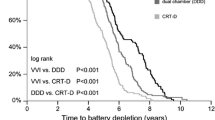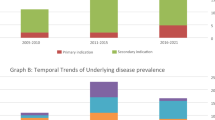Abstract
We report a single center’s preliminary clinical experience of the Sentinel (Angeion, Minneapolis, MN) implantable cardioverter defibrillator (ICD), which employs novel technologies that offer the potential for significant reduction in ICD size. Thirty-three patients have received Sentinel ICDs with a mean follow-up of 450 (range 150– 1023) days. Device shock therapy has been used to defibrillate/cardiovert 43 spontaneous episodes of malignant ventricular arrhythmia and 510 episodes of hemodynamically well tolerated ventricular arrhythmia have been pace-terminated (pace-termination failed in 6 episodes with subsequent delivery of appropriate shock therapy). There has been no arrhythmic death in this patient population. There have been 9 inappropriate shocks in 6 patients (in 2 patients for atrial fibrillation which had satisfied the algorithm detection criteria for high zone ventricular arrhythmia, in 3 for sinus tachycardia [rate greater than 180 beats per min] and in 1 due to device capacitor malfunction). Device replacement has been required for component malfunction in 3 patients. There have been no other major complications. Follow-up time to date is short and long-term device efficacy and performance remain unproven. However, our early clinical experience suggests that the innovations used to manufacture the Sentinel ICD have facilitated reduction in ICD size without compromising therapeutic efficacy.
Similar content being viewed by others
References
Cannom DS. The implantable cardioverter-defibrillator: Technology and clinical applications. In: Kloner RA, ed. The Guide to Cardiology. Le Jacq Communications, 1995;483-507.
Singer I, Slater D, Mower M. Implantable cardioverter defibrillator. In: Singer I, Kupersmith J, eds. Clinical Manual of Electrophysiology. Williams and Wilkins, 1993;361-385.
Mower M, Schumer D. Implantable defibrillator and its basic principles. In: Podrid PJ, Kowey PR, eds. Cardiac Arrythmia Mechanisms, Diagnosis and Management. Williams and Wilkins, 1995;689-699.
Bardy GH, Ivey TD, Allen MD, et al. A prospective randomized evaluation of biphasic versus monophasic waveform pulses on defibrillation efficacy in humans. J Am Coll Cardiol 1989;14:728-733.
Compton AJ, Bolouri H, Nathan AW. Arrhythmia recognition strategies and hardware decisions for the implantable cardioverter-defibrillator—A review. Med Eng Phys 1995; 17:96-103.
Kroll MW. A minimal model of the single capacitor biphasic defibrillation waveform. Pacing Clin Electrophysiol 1994; 17:1782-1792.
Dreifus LS, Fisch C, Griffin JC, et al. Guidelines for implantation of cardiac pacemakers and antiarrhythmic devices: A report of the American College of Cardiology/American Heart Association Task Force on Assessment and Diagnostic and Therapeutic Cardiovascular Procedures (Committee on Pacemaker Implantation). J Am Coll Cardiol 1991;18: 1-13.
Lehman MH, Saksena S. Implantable cardioverter defibrillators in cardiovascular practice: Report of the Policy Conference of the North American Society of Pacing and Electrophysiology. NASPE policy Conference Committee. PACE 1991;14:969-979.
Greatbatch W, Holmes CF. The lithium/iodine battery: A historical perspective. Pacing Clin Electrophysiol 1992;11: 2034-2036.
Brewer JE, Perttu JS, Kroll MW, Donohoo AM. Dual level sensing significantly improves automatic threshold control for R wave sensing in implantable defibrillators. The Angeion Corporation. Pacing Clin Electrophysiol 1996;19: 2051-2059.
Seldinger SI. Catheter replacement of a needle in percutaneous arteriography. New technique. Acta Radiol 1953;39: 368-376.
Singer I. Defibrillation threshold testing and intraoperative ICD evaluation. J Interventional Electrophysiol 1997:741-763.
Luceri R, Zilo P, Weiss D. The implantable cardioverter defibrillator: Modern implantation techniques and their impact on outcomes. In: El-Sherif N, Lekieffre J, eds. Practical Management of Cardiac Arrhythmias. Armonk, NY: Futura Publishing, 1997;287-294.
Thakur R, Souza J, Chapman P, Troup P, Wetherbee J. Direct comparison of monophasic, biphasic and sequential pulse defibrillation over a single current pathway. Can J Cardiol 1996;12:407-411.
Chapman PD, Vetter JW, Souza JJ, Wetherbee JN, Troup PJ. Comparison of monophasic with single and dual capacitor biphasic waveforms for nonthoracotomy canine internal defibrillation. J Am Coll Cardiol 1989;14:242-245.
Lin JH, Stotts LJ, Rosborough JP, Frederick H. Comparison of defibrillation efficacy using biphasic waveforms delivered from various capacitane's/pulse widths. Pacing Clin Electrophysiol 1997;20:158-162.
Block M, Breithardt G. Optimizing defibrillation through improved waveforms. Pacing Clin Electrophysiol 1995; 3:526-538.
Saksena S, An A, Mehra R, et al. Prospective comparison of biphasic and monophasic shocks for implantable cardioverter-defibrillators using endocardial leads. Am J Cardiol 1992;70:304-310.
Irnich W. Optimal truncation of defibrillation pulses. Pacing Clin Electrophysiol 1995;18:673-688.
Natale A, Sra J, Krum D, et al. Relative efficacy of different tilts with biphasic defibrillation in humans. Pacing Clin Electrophysiol 1996;19:197-206.
Singer I, Lang D. The defibrillation threshold. In: Kroll MW, ed. Implantable Cardioverter Defibrillator Therapy: The Engineering-Clinical Interface. Kluwer Academic Publishers 1996;89-129.
Author information
Authors and Affiliations
Rights and permissions
About this article
Cite this article
Morgan, J.M., Roberts, P.R., Allen, S. et al. Preliminary Single Center Clinical Experience of the Use of a New Implantable Cardioverter Defibrillator. J Interv Card Electrophysiol 2, 357–365 (1998). https://doi.org/10.1023/A:1009760605033
Issue Date:
DOI: https://doi.org/10.1023/A:1009760605033




